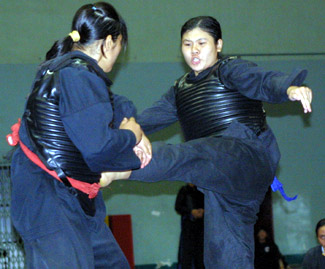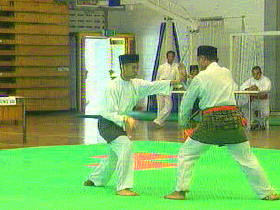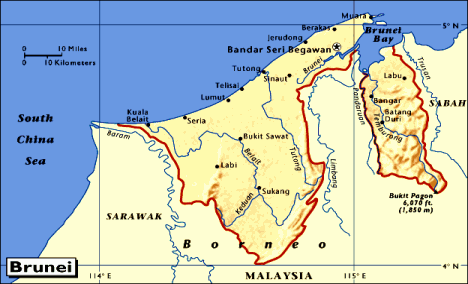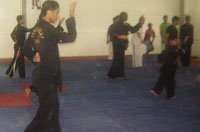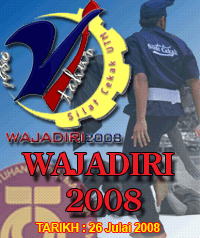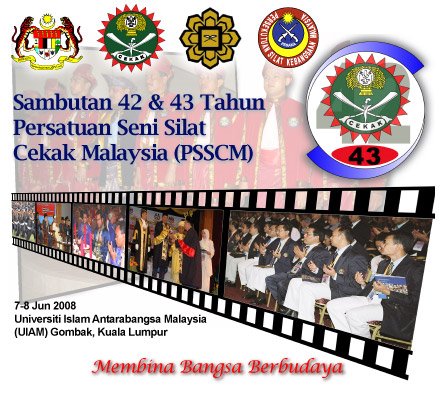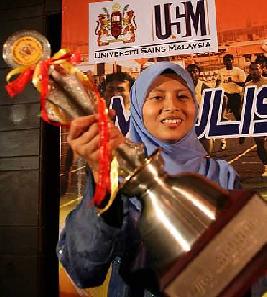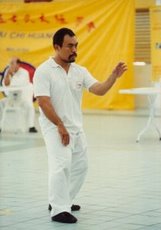“Remind me again. We’re driving all this way to Johor to meet who?” I asked.
“It’s my old sparring partner. We trained in Silat Tapak Sendeng together in the 60’s,” replied Pak Din, as he fixed his songkok.
“I thought you said you studied that style alone. You never mentioned a training partner,” I huffed.
“That’s because I couldn’t trust any of you kids. You’d have got me into trouble,” he said, referring to the first batch of 20-odd students he had when I was younger, one of whom was me.
Trust us? What secret lay so great in the knowledge of a training partner that would get him in hot soup? Now I was curious. Pak Din was never very talkative when I was a child, but maybe that’s because we had nothing to talk to him about. Twenty-four years ago, we were just snot-nosed kampung kids whose parents sent us to study silat to keep us out of trouble.
I still remember that first day I saw Pak Din. It was 1984. My mother had taken me to Datin Mariesa’s house to attend her daughter’s wedding; my first ever. It was held in a grand compound in her late husband’s home. Back then, it was an impressive sight; the only house in the village made fully of bricks. It was a single-storey, bright blue building with a dark red roof and cream-coloured grills on the main door and windows.
The midday sun bounced off the white tents in the yard, which shadowed long tables laid out with crockery and cutlery for the lunch guests. The yard was filled with adults and children in multi-coloured baju melayu or baju kurung; chattering away, greeting one another, or just running around.
The kugiran (music band) were oblivious of the crowd, and just spent the time tuning their guitars and violins, while the accordion player found activity in gossip. The female elders were seated inside the house around the pelamin (wedding dais) where the raja sehari (king and queen for the day) would sit on decorated chairs resembling thrones.
The owner of the house, the late Datuk Rahman, was the Kampung Tanah Budi headman before he passed away just six months before. It was his dream to see his daughter married, but she always turned down any potential suitors her father introduced, most of them obscenely wealthy. She became known as a bringer of bad luck, of being accursed.
A man of high standing, her father was ashamed that he had a 30-year old virgin in the house and decided to take matters into his own hands. He found a man of comparable status to marry her. But cancer took him before he could complete his work.
I was seven, but even I could see that the bride found it a less than perfect situation for herself. She sat on the dais next to the empty throne her husband would sit in after his entourage arrived. She wore a beautiful form-fitting white kebaya dress, with beading and sequins shimmering all the way down. Sparkling earrings hung elegantly, giving her neck length, while a golden necklace made of various-sized brooches adorned her bosom.
Her hair was braided and coiled and upon that, the mak andam (traditional beautician) added a bun wig with various cucuk sanggul arranged fan-like, forming a metal halo around her head. Her fingertips were dyed in henna and her hands were placed daintily on a small embroidered pillow. The colour of her dress matched the platinum dais and the lace that covered the curtains behind her.
She looked every bit the queen, if not for the mascara running down her cheeks.
“Is she crying, mak?”
“Shhhh… She’s just happy,” my mother chided. I knew she didn’t like doing that, because she often encouraged her children to be real. I was being real. I just stated the obvious, something no one else in the party seemed to be acknowledging. But my mother also understood social politics and saving face, something she had to assimilate quickly after marrying my father and moving away from the city.
Then, I heard it. A low roar that wafted over the trees, eventually increasing in volume; the sound of kompangs beating to the singing of salutations to the Prophet. The rhythm was mesmerising. I had never heard it so powerful before; so powerful that I ran from my mother’s side to join the other children who had rushed forward to see.
The entourage was huge, even by city standards. At that age, I still couldn’t count well, but I remember the feeling of being overwhelmed by the sheer number of kompang players that led it; forty in all. Behind them, the party was headed by a white satin umbrella, under which walked the groom and the best man. I wasn’t sure if I was sure, but I could have sworn the groom looked too much like my grandfather.
He walked with a cane, and seemed to be afflicted with a backache while the best man kept dabbing his perspiring forehead with a handkerchief. The rest of the 200-strong throng seemed to stunt their step, to keep down with the old man’s pace, which, to children awaiting an entourage, is a grueling one.
Eventually, the group reached the porch of the house, where the mak andam and gang were already waiting. This was what everyone was waiting for, the pantun exchange.
“A pair of cenderawasih adorn the skies,
With songs of paradise they do sing,
If a flower blooms not before it dies,
Would a beetle sacrifice its wing?” inquired the mak andam to the male representative.
To which the master rhymer deftly replied:
“Songs of paradise they do sing,
Bringing calm to the realm thus wide,
Would a beetle sacrifice its wing?
Verily, body and soul we’d gladly provide”
The mak andam smiled and gestured to the groom to pass.
The old man and his best man parted from the entourage, which promptly scoured the tents to search for seats. The two men walked toward the front of the house, where the bride had already been ushered out; to meet her husband.
Her bridesmaid shielded her face with an embroidered cloth fan, both as a sign of chastity, and to hide the mascara scars she had self-inflicted. Both of them sat down on two chairs in the yard, almost as finely decorated as the thrones inside the house.
And, at that very instant, a man, probably in his forties, stepped forward. The chattering crowd went silent. He was dressed in a black baju melayu, and a black samping with gleaming gold threading, while his tengkolok, also of the same material, was tied in a fluid lang menyusur angin knot. A brush of well-groomed jet-black mustache covered his upper lip. He looked every bit the warrior. He had no keris by his side, but his eyes were piercing.
The warrior took several measured, polite steps towards the couple and raised his hands, palms together, to salute the groom, which he returned graciously, if lazily. The warrior took two steps back and folded his arms across his body, akin to the position in Muslim prayer. And he waited.
The sudden screech of a serunai broke the calm and the eerie strain of the tune seemed to inspire the warrior. His face turned from calm to concern. He closed his eyes, and when the percussion of the gendang ibu and gendang anak drums began, his fingers started to move. There was an energy that started from his fingers and seemed to radiate visibly through the elbows, the shoulders, the neck, the face.
He slapped his thigh and stepped back, while his hands made wondrous circular movements in the air. He seemed to be putting on a show for himself, as he watched his hands dance. He gestured to the left, to the right, up and down; all the time his hands mimicking birds on the wing, playing with each other.
Then, the strain of the serunai became harder, more violent, more inducive and the drums, from a lazy rhythm, jumped to a marching bang-bang-bang, like machine-gun fire, which startled the children. The warrior worked himself into frenzy, launching punches and parries, as if he was fighting an invisible foe.
I was wide-eyed. It was the most beautiful thing I had ever seen. At one point during the mock fight, the warrior seemed to be pinned down by his foe, and the children gasped. Was it a phantom? A ghost? A little girl I’d never met clung to my arm, which was disconcerting, because I was about to jump in the ring to help. The drum crescendo kept us on the edge.
Then, he lunged from the pin and jumped up, did a mid-air spin before landing on the sand, with one hand on the enemy’s throat. He crushed his windpipe, and it was over. We cheered, much to the surprise of the adults.
The warrior stood up, as if nothing had happened, saluted the groom again, and took several steps back. But, as he turned to walk away, I spotted a shoeless man walk past him. He wore a pair of scruffy jeans, which matched the scruff on his face. His once-white t-shirt told me that he had only a few of them to his name, and nothing more.
I would have paid him no more attention, but for his arm. His arm! Beneath the telling rust of a carelessly-used implement, I saw the gleam of a sharp parang hidden in a reverse-grip behind his forearm. His eyes had a wild look to them, and I followed his gaze to discover, he was looking at the bride. Her mascara-smudged eyes widened in horror and she tried to scream, but no voice came.
“I waited for you! You promised it would be me!” the wild man screamed, as he revealed the judge that he had brought along. The household seemed to be frozen. The men stood up, but everyone wondered who would make the first move, weaponless, against an amuk.
He spat obscenities at her husband, most of which I didn’t understand. All the men could do was shout ‘Hoi!’ or ‘Woi!’ or ‘Run!’ to their families, which didn’t help the bride at all. I felt a gentle but firm grip tear me away from the scene. It was my hero, mak.
“Come away!” she shouted. I couldn’t disobey, but the man in me wanted to do something. It’s what my father would do. As she pulled me away, I picked up a fist-sized rock and launched it overhand. I didn’t see where it landed, but just as I picked up another, I heard a loud crunch, and the crowd went silent.
Blood ran down the amuk’s hair and the crimson stain on his shirt grew. He turned his face and saw me. His eyes narrowed and he started to lunge towards me. I looked at the rock in my hand, and I looked at him. A growth seemed to fill my throat. I couldn’t breathe, and I couldn’t run. My legs melted beneath me as my mother dragged me across the yard, which ripped across my skin. I was bleeding into the sand.
In the haste, my mother’s grip loosened and I fell to the ground on my back, just as I smelled the stench of the wild man’s breath envelop me. My mother screamed something, but I was in a soundless void. The amuk raised the parang above my head and I saw it cleave the sky. I closed my eyes, waiting for the inevitable.
Then, from a distance, I heard something rip through the wind, and a loud snap, like a breaking branch. I dared to open my eyes and found the parang embedded in the earth, barely three inches away from my right shoulder. The wild man’s knee had fallen dangerously between my legs. I could still smell his breath, but something was wrong. He wasn’t looking at me.
His head was turned over his shoulder, and I saw what caught his evil stare. Standing there in a half crouch, was the warrior, still in full dress. He was holding one end of a taut sarung in his hands, while the other end was wrapped around the amuk’s weapon arm. It was so tight, it tied his hand to the blade.
If he was angry before, now the amuk was insane.
“You! Not you, too! She promised! You’ll die with them!” he cried as he got up and tried to rush the warrior with his sarung-wrapped parang, accidentally kicking my ribs along the way. My eyes welled up with tears, but it hurt too much to move. My mother was screaming hysterically as she was held back by several women who tried to keep her out of the melee.
The amuk shot past the warrior and in the process, the sarung fell away from his arm. The parang was free again. The warrior, who evaded his lunge, had repositioned himself to face him. As the amuk turned around, the warrior gracefully skated across the sand and threw his hand across the wild man’s face, violently slapping his cheek with the sarung.
But as he fell, the parang continued its downward arc towards the warrior’s skull. Without even stepping, he shifted his hips and slammed a left tiger fist into the amuk’s armpit, which forced the weapon free. As it fell, the blade bounced off the warrior’s right thigh, and made a bloody gash; nearly slicing my ear off. The warrior grimaced for a split second, but just as suddenly regained his calm.
A look of resolve came over his visage. He stepped behind the amuk and swung the sarung across his jugular. The amuk suddenly realised the precarious situation he was in; he struggled feverishly and tried to stab his elbows into the warrior. But it was too late. He felt the sarung tighten, as the warrior screwed it from behind. A foot placed squarely on his tailbone ensured that his hips were firmly pinned to the ground.
The amuk’s eyes went wide as he choked on his own saliva. His head was now on the ground and as his gasps became quieter, he looked at me contemptuously and mouthed: “Wait for me…”
As the crowd cheered wildly and my mother scooped me up in her arms, no one noticed that the bride was no longer where she sat. In the commotion, her husband had failed to see her slip away. People rushed forward to congratulate the warrior, but he was busy tying up the amuk with some weaved rope. What for, I thought. Isn’t he dead?
I saw the warrior turn the man over and place his thumbs on either side of his jugular. He massaged rhythmically for several seconds and almost immediately, the man started growling. The shocked crowd backed away a little, but came back when they saw that he was immobilised. The warrior turned him over to several village committee members, who probably found courage in numbers.
My mother turned to me, checked the scratches on my legs, dusted me off and fretted the whole time with tears streaming down her face. I couldn’t hear what she was saying, because I was staring. Staring at the warrior who stood there, looking at me. My mother noticed my swayed attention, and she got up and walked us over to him.
“Thank you very much. You saved my son’s life,” she offered, sniffing.
“It’s all right. Just get his wound cleaned quickly. And give him some water to drink. He’s had quite a shock. He still looks shocked,” the warrior remarked. My mother nodded, and turned us to leave, when I spoke.
“I’m not shocked”.
Both of them, surprised, looked at me, waiting to see if I would say anything else. It was a few seconds before I finally decided on my choice of words.
“I want to be like you,” I said. “I want to be a warrior”.
A smile crept onto his face.
“What’s your name, young man?” he asked.
“My name is Saiful, sir,” I replied.
“My name is Haji Mokhtaruddin, but you can call me Pak Din”.
A sudden police road block brought our reminisces to an abrupt halt. Pak Din quickly put out his self-rolled cigarette and stuffed it into his pouch. I chuckled to myself.
“I’m the one driving. You don’t have to do that,” I said.
“It’s a sign of respect. They’re doing their job, day in day out in the sun to protect us. They deserve our respect,” he retorted.
“Yeah, like they respect us when they ask us for money,” I grumbled.
“Nobody likes to lower themselves to ask for bribes. It’s not in human nature. They always do it out of necessity or weakness. We have to accept that. But one thing is for sure. Everyone deserves respect, even those who would kill us. If we are able to stop our enemies, why go all the way and kill them?”
The amuk, I thought. Pak Din let him live. True, he was sent to jail, but after he left, he moved to Johor and lived a fruitful life. He opened up a youth training centre for the State Fisheries Department. If Pak Din had dealt the killing blow back then, hundreds of young men would have nowhere to go.
“You know, because of you, I had to try and recall what my masters taught me? I think I forgot more than I remembered. You started a freak trend in the kampung, calling all the local kids to come study silat at my house. Mak Jah was furious. She never got a quiet night since. Neither have I,” he laughed.
“But after your batch left, the younger ones didn’t seem to have the same drive,” he half-sighed, then caught himself. Sighing is taboo in Melayu culture. It indicates a sense of giving up. It was clear, however, that Pak Din was disappointed. And most of it had to do with me.
“Do you remember the bride on that day? The one who ran away?” he asked suddenly.
“Yes. Azizah, I think. They never found her. I heard later that she was in love with Rashid, the amuk, but he was too poor to ask for her hand in marriage. It didn’t help that her father’s dying wish was for her to marry a decrepit old man,” I said, then laughed, remembering Pak Din’s crack about decrepit chain-smoking old men.
“We’re here,” he quipped, as we stopped in front of a cream-coloured terraced house with a brown roof. A woman was in the fenced-in garden watering her plants. Pak Din got out of the car and said, “Assalamualaikum”.
The woman stopped her gardening and walked to the fence while an old man came out of the house. She smiled at both of us, but when she looked at me, she smiled even wider and said, “Hello Saiful, you’re a grown man now. Long time no see.”
My brow furrowed for a couple of seconds, until the face became familiar. The old man came into view, and suddenly, I froze.
“Azizah? Rashid?”
Pak Din turned to me and smiled cheekily.







